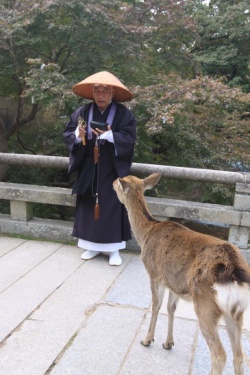Incarnation
Incarnation literally means embodied in flesh or taking on flesh. It refers to the conception and birth of a sentient creature (generally a human) who is the material manifestation of an entity, god or force whose original nature is immaterial. In its religious context the word is used to mean the descent from Heaven of a god, or divine being in human/animal form on Earth.
In the teaching of the Buddha sentient beings incarnate due to the psychological factors of ignorance, craving and clinging which results in the phenomenon of becoming and rebirth. To be born human is considered a great privilege because unlike other mammals even a person of average intelligence with sufficient effort and proper guidance can walk the path of dharma and become liberated from the cycle of rebirth. The motive force in the process of material incarnation and becoming (popularly known as 'life') is attachment to and identification with matter. This ignorance gives rise to the volitional factors which are called sankharas. These sankharas through the infinite possibilities of worldly desires propel the human being through the pattern of repeated birth and death until the dawning of wisdom (awakening) brings about the desire for liberation.
According to Buddha's teaching the soul (as that structure of sankharas that gives rise to incarnation and animates the body during 'life') is not a fixed entity but in a state of constant flux - being modified over time by actions of body, speech and mind. The constant transmutation and interdependence of phenomena mean that nothing can be said in terms of ultimate truth to have a fixed identity. This is the doctrine of anatta, the no-self doctrine applying to all phenomena (see Three marks of existence).
Liberation in Buddhism is achieved when the stock of accumulated sankharas buried in the unconscious have been dissolved through the practise of the Noble Eightfold Path, a path leading to the experience called enlightenment (Bodhi in Sanskrit and Pali). At enlightenment all the causes for future rebirth have been deleted and the sage abides in a state of being called deathlessness (Amaravati or Amrta). Such a one - called an arahant or Buddha is no longer destined for reincarnation after death.
In Tibetan Buddhism, an enlightened spiritual teacher (lama) may choose to reincarnate after death in order to continue to help people. Such a teacher is called a tulku.
According to Tulku Thondup,[5] there are three main types of tulkus. They are the emanations of buddhas, the manifestations of highly accomplished adepts, and rebirths of highly virtuous teachers or spiritual friends. There are also authentic secondary types as well which include unrecognized tulkus, blessed tulkus, and tulkus fallen from the path.
